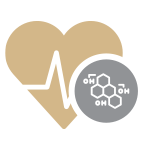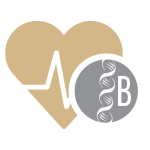Advanced Cardiovascular Labs FAQ

Testosterone with Sex Hormone Binding Globulin
The symptoms of low testosterone include, but are not limited to, low sex drive, fatigue, reduced lean muscle mass, weight gain, sleep disturbances, irritability, erectile dysfunction (in men), and depression. The symptoms of high testosterone include, but are not limited to, acne, aggressive/risky behavior, excessive body hair, headaches, high blood pressure, high sex drive, increased appetite, mood swings, prostate enlargement (in men), and fertility issues.
This test provides us with the total testosterone as well as the ability to determine how much available for use by the body. The value of the SHBG can indicate if the testosterone deficiency is due to obesity or part of an age-related process. After the age of 40, testosterone levels have been shown to decrease and that decrease is associated with an increase in all cause mortality as well as an increase in of CV risk1.

Anti-Muellerian Hormone (AMH)
The AMH level reflects the approximate size of the pool of remaining eggs a woman has, and may be the best biochemical marker of ovarian function. In adult women, AMH levels gradually decline as the amount of eggs decline with age, and becomes undetectable at menopause. AMH levels can be used in patients planning in-vitro fertilization (IVF), identifying reduced egg levels in certain patients (such as those with infertility, cancer patients, or those with significant ovarian injury from radiation or surgery). Although this is a useful tool in women with infertility, it cannot predict future fertility in those who are not currently experienced difficulty with fertility and cannot predict menopause. Unlike other hormone tests, AMH can be measured anytime during the menstrual cycle and typically demonstrates minimal variability. A study found that an inverse association between AMH concentrations has been associated with increased CV disease in premenopausal women1.

Estradiol
Of the three major forms of estrogen, estradiol is the most potent. In non-pregnant women, estradiol originates in the ovaries, with smaller amounts originating in other tissue. Measuring estradiol can help with the evaluation of irregular menses, infrequent menses, lack of menses, ovarian insufficiency, disorders of puberty, infertility, evaluation of estrogen-producing tumors, and evaluation of hormone-related feminization in men. In order to best evaluate estradiol’s role in menses irregularities, it is important to note what day of the menstrual cycle the labs were obtained, as hormones fluctuate throughout the month. Research suggests that healthy levels of estradiol is cardioprotective in younger women and may be the cause of increased cardiovascular risk in the postmenopausal population regardless of risk factors1.
1. 10.1097/MNH.0b013e3283431921

TSH Reflex to Free T4
TSH stands for Thyroid Stimulating Hormone. Free T4 is a thyroid hormone, whereas TSH is the hormone that stimulates the thyroid to produce hormone. The thyroid controls and influences many bodily functions which, when affected by abnormal hormone levels, can cause multiple symptoms.
These symptoms include, but are not limited to, changes to the texture of hair, skin, or nails (hair loss, skin may be more dry/oily, nails may become more brittle), gastrointestinal upset (diarrhea, constipation), energy changes (more hyperactive or more fatigued), heart palpitations, headaches, changes in sleep patterns, changes in weight (weight loss/gain), temperature sensitivity (feeling cold/hot), hoarseness, joint pain, mood changes, changes in menstrual patterns, noticeably enlarged thyroid, muscle weakness, and changes in sexual desire. Changes in thyroid hormone levels can be caused by abnormal thyroid function, abnormal pituitary gland function, or an autoimmune disease.
A TSH will be able to assist with identifying if hormone levels are appropriate, but may not necessarily identify the CAUSE of the abnormality. If the TSH is abnormal, a T4 test is automatically performed, which may help determine if the primary cause is originating from the thyroid or the pituitary gland, but may not assist with identifying an autoimmune disorder.

Lipoprotein (a)
Apolipoproteins are transport molecules, and different lipoprotein transport different types of lipids which circulate in the blood. Lipoprotein a [Lp(a)] is responsible for transportation of LDL cholesterol, which is commonly referred to as the “bad” cholesterol because it contributes to plaque formations in the blood vessels which can cause narrowing, atherosclerosis, and heart disease. Elevated levels of Lp(a) are associated with an increased risk of 1 ½ to 3-fold for cardiovascular disease. Unlike LDL levels which can sometimes be influenced with diet, exercise, or cholesterol-lowering medications (such as a Statin), Lp(a) levels are genetically determined and remain relatively constant over your lifetime. Lp(a) testing may be appropriate if you have evidence of early atherosclerosis or a strong family history of early atherosclerosis without explanation by traditional risk factors. Traditional risk factors include an elevated LDL, decreased HDL, presence of hypertension, presence of diabetes, and a smoking history.

Apolipoprotein B
Apolipoproteins are transport molecules, and different lipoprotein transport different types of lipids which circulate in the blood. Apo B plays a central role in carrying cholesterol and triglycerides, and eventually LDL (the “bad” cholesterol). This test specifically measures only Apo B-100, which is associated with an increased risk for cardiovascular disease when elevated. Apo B testing is recommended for individuals with a strong family history of heart disease, high cholesterol, and/or high triglycerides.

Insulin Test
Insulin is an important hormone produced by the pancreas. Insulin is responsible for bringing circulating glucose into your body’s cells to be used as energy. When a person’s blood glucose levels are elevated, it may be due to a lack of insulin, an inadequate amount of insulin, or the development of insulin insensitivity in the body, making it difficult for glucose to be brought into the cells to be used as energy.
Obesity, particularly abdominal obesity, is associated with resistance to the effects of insulin on blood glucose, often leading to type 2 diabetes mellitus. It has been shown that cardiovascular disease is associated with nearly a third of type 2 diabetes mellitus patients worldwide1.

